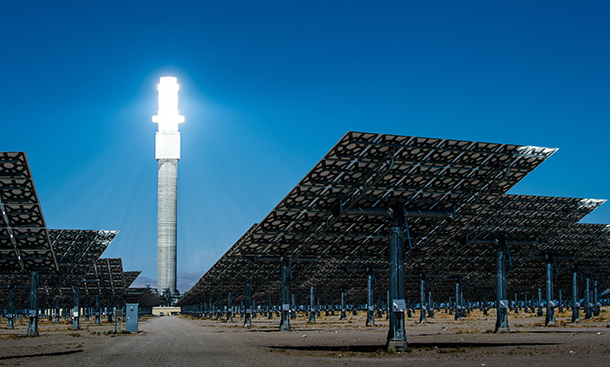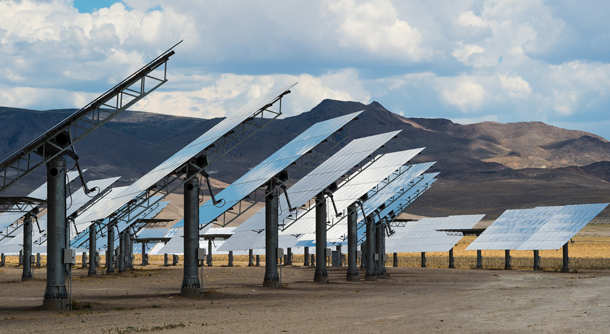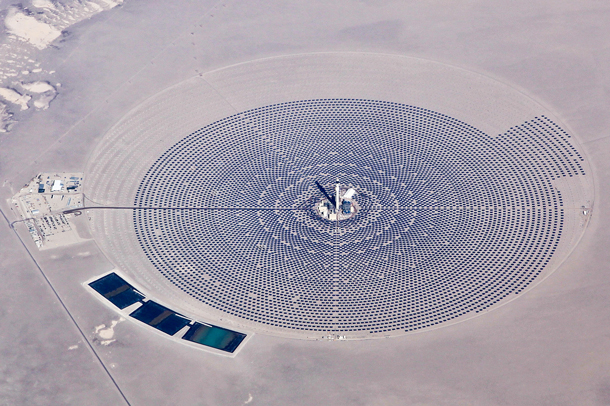Saving Solar Energy With Salt
Air Date: Week of February 2, 2018

SolarReserve’s Crescent Dunes plant in Nevada trains mirrors on a core tower to heat molten salt that can be used immediately to run a turbine to produce electricity, or stored to make electricity hours later. (Photo: Dennis Shroeder / National Renewable Energy Laboratory, Flickr CC BY-NC-ND 2.0)
Solar energy is a renewable resource, but the sun doesn’t always shine. Using molten salt to capture and store heat captured from the sun promises to save solar energy for use well into the night. Reporter Rob Dieterich joins host Steve Curwood to explain why this technology can compete with natural gas-fired power and is cheaper than grid-scale battery arrays for photovoltaics.
Transcript
CURWOOD: It’s Living on Earth, I’m Steve Curwood. It almost seems like a miracle that simply putting a silicon cell out in sunshine can instantly produce pollution-free electricity, and the solar power business is now a huge growth engine. But the challenge of course, is what to do at night, and at other times the sun doesn’t shine because batteries are still too expensive to use at the scale of the power grid.
One solution may literally be salt. A project that uses molten salt to store heat captured from sunlight demonstrates that huge amounts of energy can be stored and the heat can then power steam turbine electric generators all night long, if needed. Rob Dieterich’s article on this project in the Nevada desert recently appeared on Inside Climate News and he joins me now. Rob, welcome to Living on Earth!
DIETERICH: Hey, thank you.
CURWOOD: So, Rob, I take it that this concentrated solar power or CSP technology, as some people call it, looks a lot different from your typical photovoltaic solar panel array. Please describe for us what the Crescent Dunes system in Nevada looks like.
DIETERICH: Well, when you go out and look at this thing, it is quite amazing. First of all, it's the middle of nowhere, it's in the desert halfway between Reno and Las Vegas and as you get closer to it – even when you're still miles away – you see this 650-foot tower and there are mirrors that are shining light up at the top of it, and it's the brightest day you're going to see anywhere. In the middle the day, in the desert it's still brighter than anything else around. That's where the work is being done, basically the reflected sunlight from the mirrors, from the heliostats, is going up and heating molten salt that's circulating up and down through that tower.
CURWOOD: So, it focuses all this light on the place where the salt is. How hot does it get?
DIETERICH: What they do ... it heats it up to just over 1,000 degrees Fahrenheit.
CURWOOD: Wow.
DIETERICH: And they have two tanks. So then once they heat it up to a 1,000 degrees Fahrenheit it goes into what they call their hot storage tank. It looks like a big tank you would see at a refinery or something. It's like a large tank where they store it, and then on the other side of the plant is the cold storage tank, which is actually itself at 500 degrees Fahrenheit. You don't ever let the molten salt get really cold or what you have is salt, not molten salt.
CURWOOD: So, how does this work? How can ordinary table salt be used to store energy from the sun?
DIETERICH: The way it's used – it is actually not ordinary table salt, it's a different type of chloride, but it is salt – and the way it's used is that by heating this up you've got a really good medium for holding the heat. Once the salt is heated up to a 1,000 degrees and you put it in this insulated tank, it can sit there for days and barely lose any temperature. It basically holds that 1,000 degree temperature. Then what you do is you take that molten salt, you run it through a heat exchanger, and at 1,000 degrees you can create steam whenever you need it. The steam is then used to run what is essentially a very standard power turbine.

The very bright tower where the molten salt is heated can be seen from many miles away. (Photo: Dennis Schroeder / National Renewable Energy Laboratory, Flickr CC BY-NC-ND 2.0)
CURWOOD: And that turns a generator to make electricity.
DIETERICH: Exactly. Yes, just a standard steam turbine like GE provides all over the world.
CURWOOD: You say it's not sodium chloride, which is table salt. What kind of chloride is it?
DIETERICH: It's a blend of sodium nitrate and potassium nitrate, 60-40 of those two salts. Table salt doesn't melt until you get it even hotter than that kind of salt. So, table salt is not as good, though table salt is actually being looked at in some places because you can heat it up even hotter than you can heat up these particular salts. There's a lot of salts in the world.
CURWOOD: So, Rob, of course a key complaint about traditional solar energy is that it's difficult or expensive to store for overnight use, for when the sun isn't shining. By how many hours does storing energy with molten salt extended solar energy's usefulness?
DIETERICH: You could basically run the turbine all the way through the night if you want to. It's all just a calculation of how many mirrors you have, so how much salt you can heat up during the day and then what size turbine you run on it. At Crescent Dunes, the plant that I went out to visit which is the only real commercial scale plant of this type that's operating yet, at that facility they can store enough molten salt to run their target for 10 hours after the sun goes down based on what's in that storage tank.
CURWOOD: Now why did they pick 10 hours?
DIETERICH: These are things that get decided based on sort of what's needed on the grid at a particular place. They could have had slightly more mirrors, right, which would allow them to heat more salt during the day and they could have gone to 12 or 14 hours. So, it's just a calculation of what the grid needs, which is honestly, which is a very important thing because what's missing right now in wind and solar photovoltaics is that you – you make power from those facilities when they want to make power, you don't get to choose. With a plant like this you can set it up so that it runs for however many hours you think you need to meet your peak demand after the sun goes down.

Thousands of large independently-movable mirrors, or heliostats, surround the core tower in a circle measuring about two miles across. (Photo: Dennis Shroeder / National Renewable Energy Laboratory, Flickr CC BY-NC-ND 2.0)
CURWOOD: Rob, battery technology is much improved from what it was even a couple years ago. Companies like Tesla are using that to extend solar energy's usefulness in the nighttime hours. So, I mean to what extent could increasing efficiency of battery storage make the molten salt energy storage obsolete?
DIETERICH: It's a bit of a race. Basically what Tesla and others are putting on the utility grid now are big banks of something pretty similar to what's in your computer, just all joined together, and those prices have absolutely come down and will continue to come down. But thermal storage on a large scale, thermal storage is much much more efficient than battery storage. There’s a belief that with the current chemistry of those batteries until you get some kind of a chemistry breakthrough something that substantially more efficient, where the energy density is that much better, that you're not really going to get to the level where you've got storage on the scale and efficiency of the sort of plant that we're talking about.
CURWOOD: So, let's talk about the money. How expensive is this electricity that's produced by heating up all this salt with these mirrors so that you can then extract the energy at night?
DIETERICH: Well, that's the real wild card and the real thing that got us interested in it is that the prices appear to be coming way down. Basically the company that built Crescent Dunes Solar Reserve, when they got into this business, which is about almost a decade ago now, they were looking at being able to build this kind of plant, and they thought it would be competitive with solar photovoltaic panels. But as you know, as people who follow this now the price of solar PV panels has just plunged, so that's actually cheaper to do now. What is not cheaper is the combination of solar panels and batteries, right?
If you want to get into actual numbers, the contract for the power from solar reserves Crescent Dunes plant is 13.5 cents per kilowatt hour. That was a power contract they signed back in 2009. They now say that they can produce power for less than half that price from the next plant that they're going to build, and they actually have a plant that they expect to be in construction on in Australia, very similar to Crescent Dunes, slightly larger. They expect to get that under construction this year, and they have agreed to sell the power from that for about six cents per kilowatt hour, now that's an important threshold. Six cents per kilowatt hour is kind of the threshold that the Department of Energy and others observing this industry think is the price you need to get to if you're going to be competitive with fossil fuels. If you want to build a solar plant instead of a natural gas plant, six cents per kilowatt hour is about where that could start to happen.
CURWOOD: Now, Crescent Dunes is still one of a kind. I understand that there's a project in Australia, but where else might there be others in the works?
DIETERICH: There's another project that's in construction now built by a Spanish company and that's in Morocco. So, that is coming along and will be finished perhaps this year. There's another plant that should go into construction this year that's in Dubai and then there's companies basically in many places in the world that have projects in the pipeline and hope to get them built. There's been projects bid in South Africa, in Chile where they have really great sunshine, really bright sunshine, which makes this stuff even cheaper, believe it or not, and China is very interested in building these plants as well. They've committed to building several thousand megawatts of concentrated solar power.

A photo taken from a commercial flight during Crescent Dunes’ construction. (Photo: Matt Hintsa, Flickr CC BY-NC-ND 2.0)
CURWOOD: So, this technology in other words sounds like it works in desert areas because they tend not to rain, tend not to have clouds, and desert areas that are wide-open spaces.
DIETERICH: Yeah, I mean that's one of the obvious limitations. You've got to have a lot of land. The place I visited, that field of mirrors, is 13 million square feet of mirrors, right? It's 10,000 individual mirrors each of which can turn and point towards the sun, at any the hour of the day, turns in two axes, and that field of mirrors is pretty close, I think, to two miles across which is why building in the desert in Nevada is a pretty good choice. There's a lot of room there. And you do have to have super bright sun. Even Dubai where they're going to build another one probably starting this year, there's enough dust in the air that it's not quite as good a location. And as I was saying Chile is a great location. You get, I think, something like 20 percent more power for the same set of mirrors out of Chile just because the solar radiation that hits the ground there is that much more powerful.
CURWOOD: Hey, how safe is producing energy with salt heated to 2,000 degrees?
DIETERICH: Pretty safe. Any time you've got steam pipes and hot stuff going around through a power plant you've – you've got some risk, but this is no more risky and probably less so than you know gas or coal or anything like that. One of the more significant problems they had at Crescent Dunes was they had a leak in that hot salt tank, that big storage tank that they have out there, but when molten salt leaks, it hits the ground which is colder and it turns to salt, which is not the most dangerous thing in the world compared to a leaking tank in a refinery, right, which when it gets out it explodes, and this is, this is pretty safe stuff. You know, one of the things you haven't asked about that people do is, is it safe for birds, is it safe for pilots who might be flying an airplane near one of those bright towers, and those are things to be watched, but we need to keep in mind there doesn't seem to be evidence that it's particularly more dangerous for birds around this than it is around, say, a skyscraper in a city with reflective glass windows.
CURWOOD: So, what's needed to deploy this technology on a larger scale, do you think?
DIETERICH: I think what's needed is to prove it out still. This company Solar Reserves has been around a long time and several other companies have been working on this technology for a long time, and as I say my story the technology that they're using it goes back to a demonstration project that was operated 20 years ago. Even with all that time having passed, we've got just the one operating plant. It hasn't been without its glitches. They feel like it's all worked out and that plant’s running well now, but you've got to build two, three, four more before anybody is going to really be sure that the plants could be built to budget, they could be built on time and that they run the way everybody predicts and that the economics that are being promised when they sign contracts right now can be seen in real life.
CURWOOD: Robert Dieterich is a freelance writer. His story about solar thermal here is in Inside Climate News. Thanks so much for taking the time with us today.
DIETERICH: Thank you.
Links
Living on Earth wants to hear from you!
Living on Earth
62 Calef Highway, Suite 212
Lee, NH 03861
Telephone: 617-287-4121
E-mail: comments@loe.org
Newsletter [Click here]
Donate to Living on Earth!
Living on Earth is an independent media program and relies entirely on contributions from listeners and institutions supporting public service. Please donate now to preserve an independent environmental voice.
NewsletterLiving on Earth offers a weekly delivery of the show's rundown to your mailbox. Sign up for our newsletter today!
 Sailors For The Sea: Be the change you want to sea.
Sailors For The Sea: Be the change you want to sea.
 The Grantham Foundation for the Protection of the Environment: Committed to protecting and improving the health of the global environment.
The Grantham Foundation for the Protection of the Environment: Committed to protecting and improving the health of the global environment.
 Contribute to Living on Earth and receive, as our gift to you, an archival print of one of Mark Seth Lender's extraordinary wildlife photographs. Follow the link to see Mark's current collection of photographs.
Contribute to Living on Earth and receive, as our gift to you, an archival print of one of Mark Seth Lender's extraordinary wildlife photographs. Follow the link to see Mark's current collection of photographs.
 Buy a signed copy of Mark Seth Lender's book Smeagull the Seagull & support Living on Earth
Buy a signed copy of Mark Seth Lender's book Smeagull the Seagull & support Living on Earth

